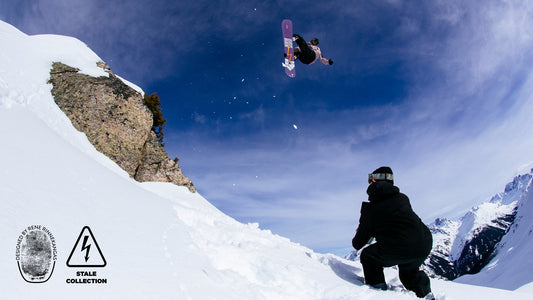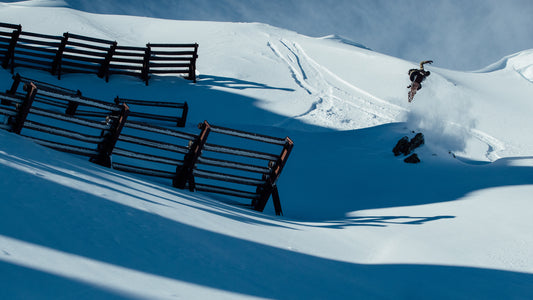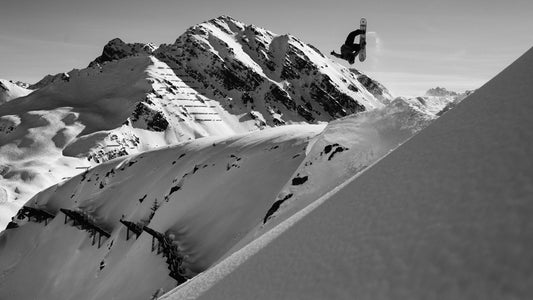Get set up out of the box

Just like when you’re choosing a pair of snowboard boots, the most important element to get right with your bindings is the fit.
This starts with the size on the box and continues with the way you set them up on the board – including stance width, angles and any other customizations. At the end of the day, the more comfortable you can make your snowboard binders, the more fun they’ll be to ride.
Let’s walk through each step:
1. What size snowboard bindings do I need?
As we explained in our deep dive on choosing your snowboard bindings, there are usually three sizes available. At Rome, these are:
- Small – US Men's 5-7, US Women's 6.5-8.5
- Medium/Large – US Men's 7.5-10, US Women's 9-11.5
- Large/XL – US Men's 10.5-12.5, US Women's 12-14
Note that these sizings don’t necessarily translate to other brands. There’s also a whole lot more you can do to customize the fit further, which we’ll cover below.
2. Adjusting the baseplate
Rome’s bindings enable you to adjust the overall length of your binding so that it’s a perfect fit for your boot.
To do this you need to remove the footbed (there’s one screw holding this in place) and then unscrew the bolts connecting the heel hoop to the baseplate. There are three of these on our AsymWrap platform, and four on the FullWrap.
Holding the baseplate in one hand and the heel hoop in the other, you can slide it in and out to your desired length. Check the fit against your boot and screw it back up.
3. How to mount your snowboard bindings
Provided you know how to operate a screwdriver (duh!), fitting your new bindings to your snowboard is a simple task.
Take out the two disks and mounting hardware. Fold or remove the footbed of your front binding so you can access the baseplate, and insert the first disk. Rotate it to your desired angle with the help of the arrow. Each notch moves the angle by 3 degrees, so if you want an 18 degree angle it’s one notch past the 15 degree marker point.
The slots in the disk enable you to fine tune the position of the binding forward and back, so that your foot is centered across the board without too much toe or heel overhang.
Place the binding onto the board so that the insert holes at your desired stance width can be seen through the slots. Once you’re happy with the position and angle, place four washers into the slot and simply screw the binding down. Work your way around each screw in turn, getting it lightly threaded on the first go round before tightening things down fully. Repeat the process on your rear binding.
4. Adjusting the strap length
Place a boot into the binding. It’s best if your foot is actually in the boot at this stage, so it’s expanded to the size it’ll be when you’re riding and you can feel the effect of any changes.
Rome straps offer tool-free customization. Simply flip open the lever on the inside of your ankle strap and slide the padded section in either direction until it’s nicely centered over your boot. Close the lever, then insert the ankle ladder into the ratchet on the other side and crank it down. How does it feel? The strap should still be in the sweet spot, with a few notches to spare on the ladder. If you’re the kind of rider that likes to run a really tight strap then you might need to re-open the inside lever and shorten it further.
The toe strap works in much the same way. Adjust the length so that you can easily engage the ratchet (you shouldn’t be struggling to get it over your boot) but not so loose that you’re running out of teeth on the ladder when cranked. Repeat the process on the other binding.
5. Adjusting the PivotMount
On our premium quality binding models including the Vice, the Guild, the Katana, and the all-new Cleaver you can do more to customize your ankle strap than just adjust the length. Our PivotMount system also allows you to fine-tune the way in which the strap sits across your boot.
It works by using an additional joint on each side of the binding. The strap connects to this pivot (rather than directly to the baseplate) and can then be rotated around into different positions – kinda like a kid’s arms when they’re pretending to be a steam train.
There are two versions of PivotMount, depending on the binding model. The Regular version has four positions on each side, enabling 16 permutations in total; the PivotMount Max offers eight positions on each side, or 64 options in total.
When the strap is in a higher position, it will lock your ankle in more securely and give you greater power during turns. On the flipside, as you move it gradually lower, it makes for a looser, skate-like feel. By having it set to different positions on each side, you can create asymmetric configurations whereby the strap is angled slightly across your boot, further customizing how you can move and tweak.
As with all the settings on your bindings, it’s a good idea just to experiment with a bunch of options to see what works best for your riding style.
6. Should I add forward lean?
Every binding on the market offers the ability to adjust the forward lean. Systems vary, though most brands use some kind of block on the back of the highback. With Rome bindings, you simply flip the lever to release the adjuster and slide it up and down to your desired position, then flip it closed.
Sliding it towards the bottom will increase the amount of forward lean in the highback. This encourages you to keep your knees bent all the time and is more responsive on the heelside since you can push against the highback with very little input. Running a lot of forward lean is an aggressive set-up that’s often favored by pipe riders who need maximum edge control through transitions.
Sliding the adjuster towards the top will decrease the amount of forward lean. This creates a more relaxed and playful riding position. It’s easier to move your foot – which is good for pressing on rails – and you’re less likely to hang up, so you’ll find most park rats and street guys run minimal forward lean. Since it’s more forgiving, most entry level snowboarders are best off starting with zero or just a little forward lean and gradually dialing it up to see how it feels.
7. Rotating the highback
When they’re fresh out of the box, the highbacks on your bindings will be set up parallel to the baseplate (looked at from above). When you attach the bindings to the board and adjust the angles, you’ll see that this means the highbacks are not in line with the edge. This is normally most noticeable on the front binding, which has a steeper angle.
Whilst it’s perfectly possible to ride your board this way, you will get better performance out of your bindings if you rotate the highbacks so that they are parallel with the side of the board. The idea is that when you lean onto your heels, power is directed more efficiently into the edge.
To do this, unscrew the two bolts fixing the highback in place and twist it round to the desired position, then tighten them up.
And that’s it – you’re ready to shred!
8. Fitting Your Snowboard Bindings – The Bottom Line
- Make sure your snowboard bindings are the right size for your feet
- Fine-tune the length by sliding baseplate forward and back to match your boot
- Once you’ve decided on your stance, mount your bindings using the supplied disks and hardware; all you need is a screwdriver
- Before tightening fully, use the slots in the disk to position your boot evenly across the board
- Put your foot into your boot and adjust the length of the straps so they’re centered when the ratchets are cranked
- You can fine-tune the position of the ankle strap with Rome’s PivotMount system; go higher for more power, and lower for a looser feel
- Adjust the forward lean; dial it up for aggressive response, or dial it back to keep things more playful
- Rotate the highbacks so they’re in line with the heel edge; this will improve carving efficiency
Watch our video on binding customization



